Ramsbury's Home Front
My
interest | Aviation
Archaeology |
Ramsbury
Airfield | 101st
Airborne Division |
Savernake
Ammo Dump | Mystery
Corner | 101st
Artillery | The
Great War
Membury
airfield | Normandy
- some places of interest
| Links
Page |
Home
Page |
Obituaries
| Recommended
Reading
| Aldbourne
Stable Project
Dozens of Home Guard veterans and others who grew up during this period were interviewed by author, Roger Day, in preparation for this book about the history of the Marlborough Battalion of the Wiltshire Home Guard. The Battalion covered a large area and included many of the villages surrounding the town. Much previously unpuplished material about the defence of Marlborough during WWII has been included giving a unique insite to the wartime history of the town - price £12.95 - to order copies please contact Roger at: roger@ramsburyatwar.com
For
up to the minute information please visit ![]()
Air
Raid Precautions
The ARP was brought
into being in Britain in 1937 because of government concerns regarding a possible
future war with Germany and the threat that might come from the air. ARP wardens
had numerous duties to perform but their main task was to warn the population
of air-raids. In rural communities like Ramsbury this was often done by wardens
riding bicycles through the village streets, blowing short blasts on a whistle.
If poisonous gas was suspected then a wooden rattle was used. Fortunately Ramsbury
was never deliberately bombed. However during the early years of the war enemy
raiders would often fly over the village on their way to places such as Bath
or Coventry and this kept the wardens at a high state of alert. When the blackout
regulations came into force it became an offence to show a light after dark
and the cry of 'put that light out' became the wardens' catch phrase.
Below
centre: Mr W.A. Smith in
his anti-gas suit (light). Mr Smith was Chief Warden in Ramsbury during the
war. (Mrs R. Connor).
Below left: Early
style Air Raid Precaution sew-on patch. Below
right: In September 1941 the ARP and other
organisations such as the Fire Service were reorganised into a single structure
called Civil Defence. All wardens were issued with this new style badge.


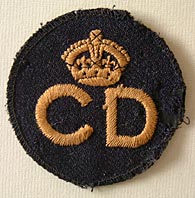
Below left: A reconstruction photograph of a Chief ARP Warden wearing a post September 1941 uniform. Below centre: Examples of most types of British WW2 respirators. Below right: An ARP gas rattle, whistle and instruction leaflet.
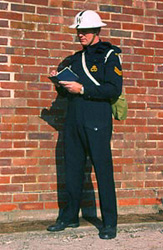

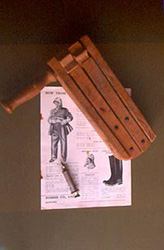
Home
Guard
This volunteer
army first came into existence in May 1940, although at this time it's official
title was the Local Defence Volunteers (LDV). Initially no weapons or uniforms
were available so the men had to train with pitch forks and shot guns. Their
job was to form a back-up to the regular army should the Germans invade, and
many units (especially in the south-east of England) were used to round up enemy
pilots who had bailed out of their aircraft. It was in August 1940 that the
LDV became the Home Guard at Winston Churchill's suggestion. Ramsbury's platoon
consisted of 65 men and their HQ was the Wesleyan Chapel in the High Street.
After D-Day the likelihood of a German invasion was considered remote and the force was eventually disbanded in December 1944.
Below: Ramsbury Platoon photographed at the school in 1944. (Via J. Day).

Below
left: Reconstruction
photograph showing a member of the Home Guard. Note leather belt, anklets and
P17 rifle typical of the type of equipment issued to most Home Guard units.
(Photo courtesy Seimon Pugh-Jones).
Below right: Following the disbanding
of the Home Guard in December 1944 all members were issued with a certificate
of service.
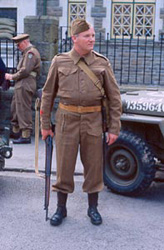

Below left: Many Home Guard platoons were issued with a weapon called a Northover Projector. It was a crude but simple device which was easily manufactured, consisting of a hollow metal tube mounted on a tripod. The 'Northover' was designed to fire the self igniting phosphorous grenade (SIP) and 24 of these grenades were packed into wooden crates like the example shown here. Below right: On the inside of the lid was screwed an enamel plate entitled 'Precautions'. This particular plate was found recently in the village of Aldbourne.
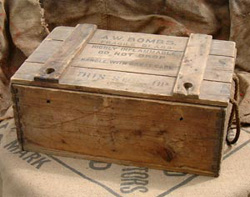
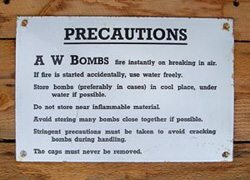
Below centre: An ammunition box, also from Aldbourne, which once contained 1,248 practice cartridges (.303 inch) in cartons. Remarkably it still retains a number of its original paper labels and two of these are reproduced below (left and right).
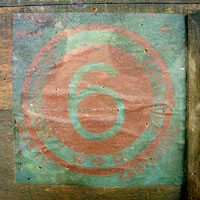
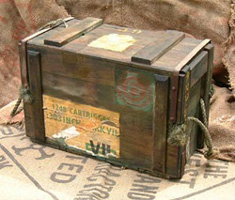
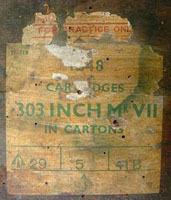
Below: Home Guard shoulder county and battalion titles worn on the upper arms of battledress blouses and greatcoats. The abbreviations WTS and BRX stand for Wiltshire and Berkshire respectively.
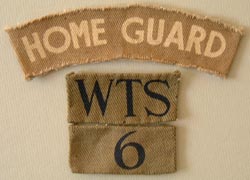
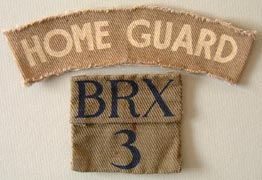
Air
Training Corps
The
Air Training Corps (ATC) was formed in January 1941 as a way of identifying
suitable candidates for the Royal Air Force before they became old enough for
military service. Many cadets often travelled long distances just to get a flight
in an aircraft. However Ramsbury's ATC members were lucky, having an aerodrome
on their doorstep, and often flew with the RAF in Airspeed Oxford training aircraft,
and later with Americans in C-47 Dakota's.
Below: Ramsbury's ATC Flight Commander, Mr H.G. Ludlow. (P. Ludlow).

Prisoners
of War
In 1941
a Prisoner of War camp was established at Lodge Farm, near Baydon. When it first
opened it housed Italians who had been captured in North Africa. It was classified
as a labour camp for prisoners who had volunteered as agricultural labourers,
thus providing a useful supply of manpower to local farmers. The prisoners wore
a uniform similar to the British battledress, but chocolate brown in colour
with large circles of red cloth stitched onto the back of the jacket and the
left trouser leg. Later in the war the Italians left and their place was taken
by German POWs.
Below left: Cigarette holder manufactured from scrap metal by an Italian prisoner. Below centre: A group of Italian prisoners on Ramsbury airfield. The men are possibly on their way home after the war had finished. Many were not allowed to leave until as late as 1948. (H. Williams). Below right: Two wooden bookends made by a German prisoner at Lodge Farm Camp in 1946.
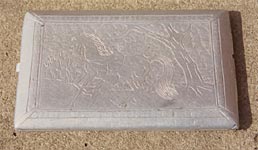

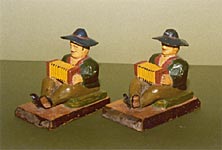
My
interest | Aviation
Archaeology |
Ramsbury
Airfield | 101st
Airborne Division |
Savernake
Ammo Dump | Mystery
Corner | 101st
Artillery | The
Great War
Membury
airfield | Normandy
- some places of interest
| Links
Page |
Home
Page |
Obituaries
| Recommended
Reading
| Aldbourne
Stable Project
© Copyright 2014 Roger Day